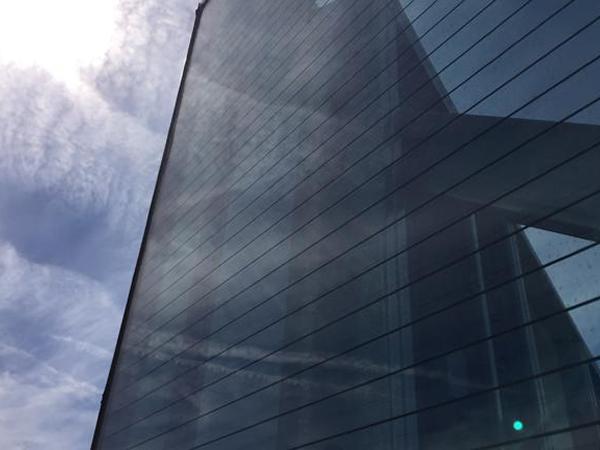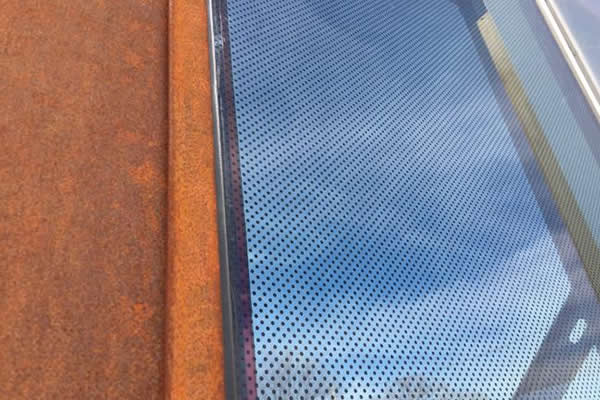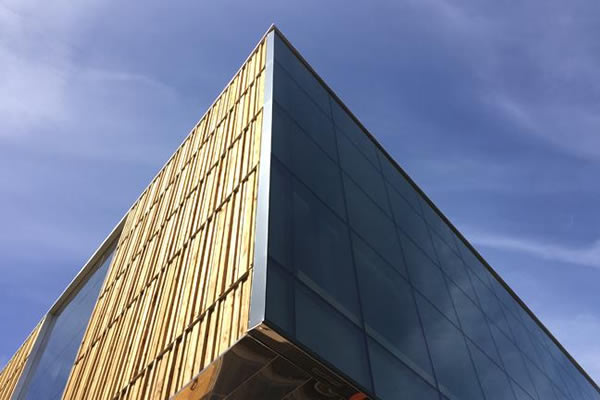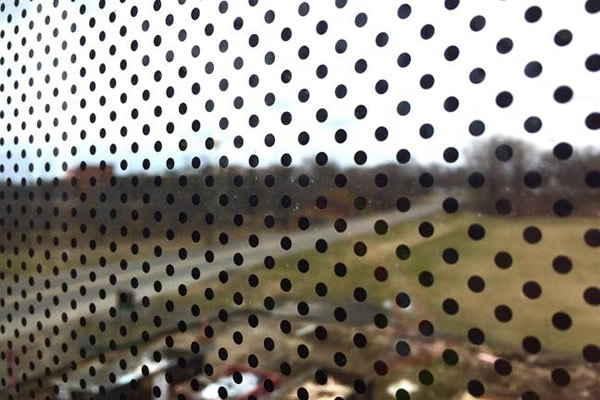
The glass features line or dot patterns that are screen printed onto the surface of the glass. This type of glass, known as fritted glass, is a feature designed for energy efficiency that has also been found to help birds avoid deadly collisions with the glass.
Birds don’t understand glass the same way people do. They fly towards habitat or sky reflected in or seen through windows, often with fatal consequences. According to a 2014 study by the Smithsonian Migratory Bird Center and U.S. Fish and Wildlife, an estimated 365 million to 988 million birds die each year from building collisions in the United States.

"What's most critical is that birds see the glass on a building as a solid object and not as something to fly towards. We can help birds avoid glass collisions in many ways, especially through building designs like those incorporated in the Bell Museum,” said Joanna Eckles, conservation program manager from Audubon Minnesota who consulted with the museum’s design team.
Less than 30 percent of the Bell Museum is comprised of glass, but the glass is used to create large expanses in the lobby and two storybox windows on the museum’s second floor that could create hazards to birds if proper measures were not taken.
Identifying the right frit patterns and sourcing low reflectivity glass types were essential to the project and met Audubon and Minnesota Sustainable Building guidelines. While new industry protocols are rapidly developing, this effort wasn’t without its challenges.

“There are no hard and fast rules when it comes to what makes a building bird safe,” said Doug Bergert, project designer with the Minneapolis office of architecture and design firm Perkins+Will, which designed the new museum.
“In order to make the glass bird safe, we had to not only think about the glassitself but also our interior and exterior lighting choices as well as the landscape design.” Bergert noted that Perkins + Will worked with Owatonna, Minn.-based ViraCon to fabricate the windows, which have now been installed on the facility.
For the Bell, Minnesota's official natural history museum, the decision to incorporate emerging bird-safe design elements in their facility was an easy one.
“We strive for every part of this building to help us celebrate Minnesota’s natural resources and wildlife, and get people excited about science—especially the innovative work happening at the U of M,” said Bell Museum executive director Denise Young.

Audubon Minnesota, the Bell Museum, and others are partners on Project BirdSafe, a multifaceted initiative aimed at reducing hazards to birds, such as those from collisions, cats, habitat loss, and climate change.
The project also has collected over ten years of data from citizen science volunteers who monitored their environs for bird-window collision events.
Two graduate students, Sami Nichols and Abigail Anderson, from the University’s College of Food, Agricultural and Natural Resource Sciences are using this data to further investigate patterns and processes of bird-window collisions.
“My work has two overarching goals: reduction in bird-window collisions and increased public awareness of bird conservation,” said Anderson.
“The way I see it, the Bell’s bird safe glass advances the same goals. Killdeer, eastern bluebirds, and eastern kingbirds are just a few of the species I’ve observed in the open and woodland habitats surrounding the new museum, and I’m hopeful that these and other species will be seen by future Bell Museum visitors, helping to connect what goes on inside the museum with the larger world.”
Eckles emphasizes that there is not a single product or measure to ensure bird safety. "A combination of decisions is key to help birds see and avoid glass. The earlier you incorporate these measures into your project, the more creative and beautiful options you have and the better off you—and the birds—will be.”
Audubon Minnesota is a leader in the development of bird-safe building guidelines and efforts to educate architects and planners to promote solutions in building design and operations.
"The attention to bird-safe design at the new Bell Museum is a shining example of what is possible when we work together to protect and preserve the bird populations that are vital to our ecosystem," said Eckles.
About the Bell Museum
The Bell Museum is Minnesota’s state natural history museum, founded in 1872. The museum is part of the University of Minnesota's College of Food, Agricultural and Natural Resource Sciences, and is set to open a new museum and planetarium in 2018. Our mission is to ignite curiosity and wonder, explore our connections to nature and the universe, and create a better future for our evolving world.
For details, visit bellmuseum.umn.edu.


 You are not logged in, please sign in to view contact
You are not logged in, please sign in to view contact Info release
Info release Promotion
Promotion Building shop
Building shop Online business
Online business